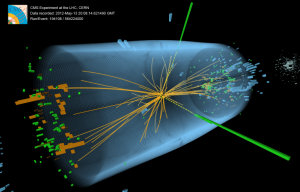Science in Brief: The Higgs Boson
 Did you ever find yourself at a party and dying to explain the Higgs Boson? Well this explanation should suffice for scientists and non-scientists who want to dazzle their friends with their erudition.
Did you ever find yourself at a party and dying to explain the Higgs Boson? Well this explanation should suffice for scientists and non-scientists who want to dazzle their friends with their erudition.
We know even from our own experience that once you get an object moving, it would continue moving unless something slows it down, such as friction. So we can easily see that it takes a force to either speed something up or to slow it down. Galileo figured that out for us and Newton nailed it down in his laws of motion.
Some objects require more force to speed them up than others. Trying to push a car to get it moving is harder than trying to push a bicycle to get it moving. We attribute the difference between those two things as their having different masses. We say that the car has more mass than the bicycle, so it takes more force to speed it up or slow it down.
We normally think about that mass as a property of the object alone as if it were built-in to the object. But for all we know about motion and mass, we don’t know how or why things actually have any mass at all.
One thing we do know is that all things are made out of atoms, whose parts are further composed of smaller fundamental particles. And it is the mass of those fundamental particles, when added up in an object give rise to the object’s mass.
The question faced by physicists until recently was why and how do these fundamental particles have any mass at all?
In the 1960s it was Peter Higgs and a few other physicists who realized that what we experience as mass was not something intrinsic in an object: its not just “built-in”. Instead, it seems that what seems like mass to us is really a kind of resistance to acceleration of an object as it moves through an all pervasive energy field in the universe.
To get a feel for this, imagine holding a beach ball underwater and trying to move it quickly from one place to another. The water will resist the motion of the beach ball. In this case, it is easy to see that the resistance to motion is somewhat related to properties of the beach ball. Some things can move more easily through water than others (in this case because of their size or shape). But it is also easy to see that some of that resistance to motion is due to the presence of the water. If the water wasn’t there, the beach ball would be much easier to move. So the resistance to motion is not all “built in” to the beach ball.
So consider the Higg’s Field like the water, and a fundamental particle is like the beach ball. But rather than the Higg’s field resisting a uniform motion, it resists a change in the speed of that motion.
Since we don’t see the Higg’s Field, we experience that resistance to a change in velocity as something we call mass. The reason why a car takes a force to speed it up is because all of its fundamental particles are experiencing resistance to speeding up as they move through the Higg’s Field. And the reason why the car seems more massive than the bicycle is because the car has more fundamental particles than the bicycle.
How do we get from a Higg’s Field to a Higgs Boson? In the bizarre world of quantum mechanics fields have field-like properties (such as a body of water) and particle-like properties (such as each water molecule in a body of water).
Over the last 30 years or so, our scientific models predicted the presence of a whole series of fundamental particles, which we have been able to find using ever larger particle accelerators. The one holdout, was the heaviest one, the elusive Higg’s particle. It took the incredible high energy Large Hadron Colilder to finally coax Higg’s particles to be produced in the zoo of fundamental particles flying out of the colliding protons.
The Higgs was the most interesting since it is the one that explains mass, and it was the last one predicted by our scientific models, specifically what is called The Standard Model.
The finding of the Higgs Boson is probably as significant as any other great scientific discovery one can think of. What makes it interesting for physicists is that The Standard Model still has a few problems in its predictive accuracy, and so far it looks like the properties of the Higgs Boson are just different enough from the predictions that it makes life interesting Rather than being disappointed, problems like this make scientists happy that their work is not yet done, and more things about this awesome universe are yet to be discovered.
Category: Latest News



